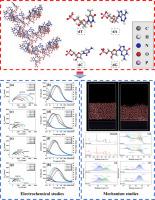DNA引物缓蚀剂对Q355低碳钢在模拟海水中的缓蚀性能及机理
IF 6.3
2区 材料科学
Q2 CHEMISTRY, PHYSICAL
引用次数: 0
摘要
采用基因合成技术,以生物序列为基础合成脱氧核糖核酸(DNA)引物抑制剂。本文研究了DNA引物抑制剂对Q355低碳钢在模拟海水中的抑制作用及其机理。质量损失和电化学测试结果表明,DNA引物缓蚀剂能显著抑制Q355低碳钢的腐蚀过程,提高其自腐蚀电位,其中4%的缓蚀浓度为最佳。抑菌率最高可达97.8%。表面形貌分析表明,添加了DNA引物抑制剂的Q355低碳钢表面粗糙度最低,腐蚀产物最少。添加4% DNA引物抑制剂后,钢表面的平均粗糙度由196 nm降至47.1 nm。元素组成分析表明,DNA引物抑制剂的抑制性能可能与其参与低碳钢表面保护膜的形成有关。此外,还从分子动力学角度探讨了DNA引物抑制剂的抑制机制。本文章由计算机程序翻译,如有差异,请以英文原文为准。

Inhibition properties and mechanism of DNA primer inhibitor for Q355 mild steel corrosion in simulated seawater
The deoxyribonucleic acid (DNA) primer inhibitor is synthesized based on biological sequences using gene synthesis techniques. This paper investigates the inhibition properties and mechanism of DNA primer inhibitor for the Q355 mild steel in simulated seawater. Results of the mass loss and electrochemical testing demonstrate that DNA primer inhibitor can significantly inhibit the corrosion process and raise the self-corrosion potential of the Q355 mild steel, and the 4 % concentration is optimal for corrosion inhibition. And the highest inhibition efficiency is up to 97.8 %. The surface appearance analysis shows that the Q355 mild steel with DNA primer inhibitor exhibits the lowest level of roughness and the least amount of corrosion products. And the average roughness of the steel surface decreased from 196 nm to 47.1 nm with addition of the 4 % DNA primer inhibitor. The element composition analysis demonstrate that the inhibition properties of the DNA primer inhibitor may be related to the participate in the forming of a protective film on the mild steel surface. Furthermore, the inhibition mechanism of the DNA primer inhibitor is examined by molecular dynamics.
求助全文
通过发布文献求助,成功后即可免费获取论文全文。
去求助
来源期刊

Surfaces and Interfaces
Chemistry-General Chemistry
CiteScore
8.50
自引率
6.50%
发文量
753
审稿时长
35 days
期刊介绍:
The aim of the journal is to provide a respectful outlet for ''sound science'' papers in all research areas on surfaces and interfaces. We define sound science papers as papers that describe new and well-executed research, but that do not necessarily provide brand new insights or are merely a description of research results.
Surfaces and Interfaces publishes research papers in all fields of surface science which may not always find the right home on first submission to our Elsevier sister journals (Applied Surface, Surface and Coatings Technology, Thin Solid Films)
 求助内容:
求助内容: 应助结果提醒方式:
应助结果提醒方式:


